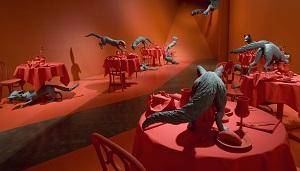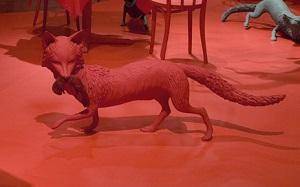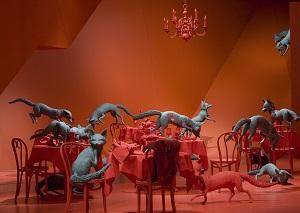This lesson allows students to use their imaginations to identify, explore, and express their understanding of Sandy Skoglund’s Fox Games. Students will create a story in response to the prompt, “This photo was captured at 3 a.m. on a security camera and you are in charge of figuring out what happened!”
Students will be able to:
- identify and list at least three elements in Fox Games;
- gain a better understanding of what installation art is;
- discuss the impact of the artist’s use of particular objects in the installation;
- use a creative writing prompt to understand what is occurring in the artwork; and
- tell or write a story based on the prompt, using evidence to explain their ideas.
Lesson
- Show the students images from Fox Games by Sandy Skoglund. Explain to the students that this is an image of installation art. Installation art is a type of art that physically changes the space it is in. Unlike paintings that hang on a wall, installation art is three-dimensional and takes up space in a museum or gallery. Museum visitors can actually walk through Fox Games like they are really a part of it!
- Ask the students to take a visual survey and verbally list all of the objects they see in this installation. Using the “Details” section from About the Art, share details the students may have overlooked.
- Ask the students to brainstorm and imagine all of the possible explanations that might shed light on what’s going on in this installation. Explain to the students that there is no wrong answer.
- Have the students imagine that somebody came up to them and said, “This photo was captured at 3 a.m. on a security camera and you are in charge of figuring out what happened!” How will they figure it out?
- Invite the older students to write a news story based on the prompt. Make sure they include “who, what, when, where, why, and how” details. Who owns the restaurant? What are the foxes doing there? When did they get in? Where did they come from? Why did the foxes want to come into the restaurant? How did the foxes get in? How do you know all these things? Remind them that they need to provide evidence and use details from the images to explain their reasoning. For example, a student could write, “These foxes entered the restaurant because they were hungry. I know this because there is food scattered around.” Have younger students create a story as a class. Allow each student to contribute an idea or sentence.
- When the stories are finished, invite the students to share what they have written. Students could even present their stories as newscasts. When everyone has shared, ask them questions such as: What did you notice about everyone’s ideas? What ideas are similar? Different? Did anybody’s story change your ideas about what might have happened?
Materials
- Paper or journals for each student to write down thoughts
- Pencils or pens
- About the Art section on Fox Games
- One color copy of the installation for every four students, or the ability to project the image onto a wall or screen
Standards
- Visual Arts
- Observe and Learn to Comprehend
- Relate and Connect to Transfer
- Language Arts
- Oral Expression and Listening
- Research and Reasoning
- Writing and Composition
- Reading for All Purposes
- Collaboration
- Critical Thinking & Reasoning
- Information Literacy
- Invention
- Self-Direction

Fox Games
- Sandy Skoglund, American, 1946-
- Born: Weymouth, MA
- Work Locations: New York, NY
Sandy Skoglund attended Smith College in Massachusetts and graduate school at the University of Iowa. She was interested in a variety of artistic disciplines and studied filmmaking, printmaking, and multimedia art. Skoglund moved to New York City in 1972 and developed an interest in photography as a way to document her large-scale pieces. Skoglund’s combination of interests is demonstrated in the hybrid of elements she uses to create her pieces, which are usually elaborate and immersive installations of imaginary, sometimes outlandish scenes. She uses aspects of theater to set the stage and cast of characters, sculpture to create interesting spaces, and paint to add bold color. Skoglund says, “If I had to say anything about my work, I think it would be that it’s almost a theme park. You can experience it in many ways.”
With much of her work, the final product has been a photograph of a meticulously staged installation rather than the actual installation itself. But Fox Games is the installation itself. The Denver Art Museum was the first museum to acquire the installation in addition to the photograph of the installation.
In Fox Games, viewers are physically immersed in the work of art as they are able to wander through the installation. “I use familiar spaces… and elements like furniture to take viewers out of the museum and place them in… a place that feels familiar to them. Then I interfere with that reality by changing the elements, changing them in terms of materials,” Skoglund says. Her artworks often take the ordinary and make it into an almost dreamlike fantasy. In this piece Skoglund submerges the viewers in a completely red environment and incorporates animals into what is normally a setting used strictly by humans. According to Skoglund, the foxes are not experiencing this environment in the same way humans would. “The foxes don’t see tables, they don’t see chairs, they don’t know they’re in a restaurant. They just experience different levels of height to jump on.”
Skoglund tries to create multiple meanings for her viewers. This piece could be a statement about how strange the familiar spaces in our lives can be. It might also be a humorous take on our tendency to go through life unaware of the magic in the spaces we move through every day. For Skoglund, it’s all about allowing viewers to participate in the process of making sense out of what they are seeing.
Details

Color
The entire restaurant scene is coated in a flat, red paint, while all of the foxes (with the exception of one red fox) are gray. For some viewers, as their eyes adjust to the all red environment, the gray foxes become a glowing green.

Details
Skoglund includes lots of details in the red restaurant scene, which contains about 700 parts. A partial inventory includes 10 tablecloths, 20 chairs, 15 bread baskets, 124 rolls and breadsticks, salt shakers, forks, knives, plastic flowers, vases, a squirrel, 27 gray foxes, and 1 red fox. All the details of a typical restaurant setting are there (along with some clearly unusual ones!)—the only thing that’s missing is humans.

Several Happenings at Once
The foxes in this piece have completely taken over the restaurant. Notice a fox in mid-air as it leaps between tables. Others lurk around on the ground or pounce and play together.

Squirrel
One of the foxes holds a red squirrel in his mouth.

Repetition
There are many repeated figures in this piece: tables, foxes, wine glasses, and chairs, among others. There are even multiple foxes in the same position dispersed throughout the installation.
Funding for object education resources provided by a grant from the Morgridge Family Foundation. Additional funding provided by the William Randolph Hearst Endowment for Education Programs, and Xcel Energy Foundation. We thank our colleagues at the University of Denver Morgridge College of Education.
The images on this page are intended for classroom use only and may not be reproduced for other reasons without the permission of the Denver Art Museum. This object may not currently be on display at the museum.






